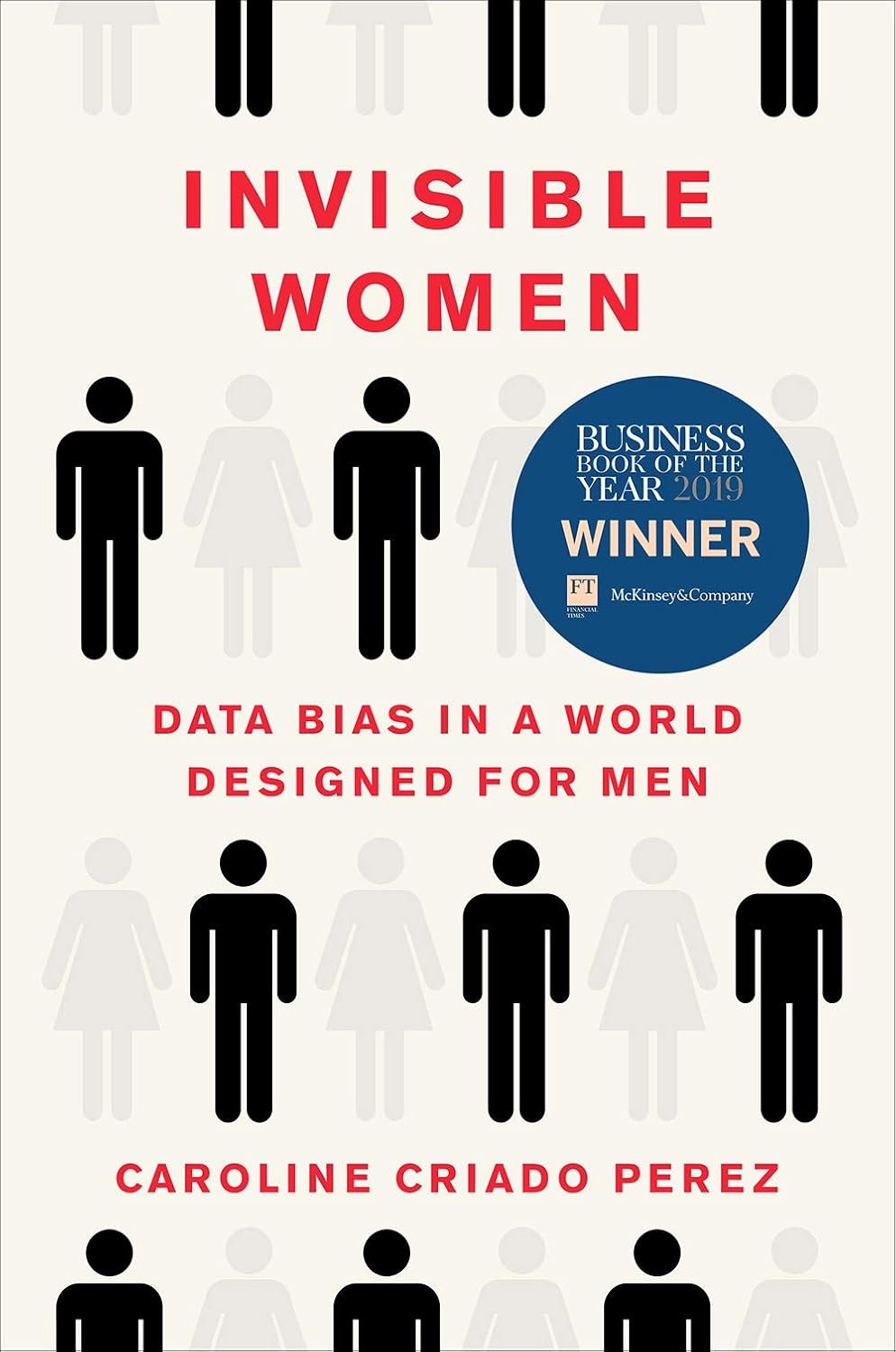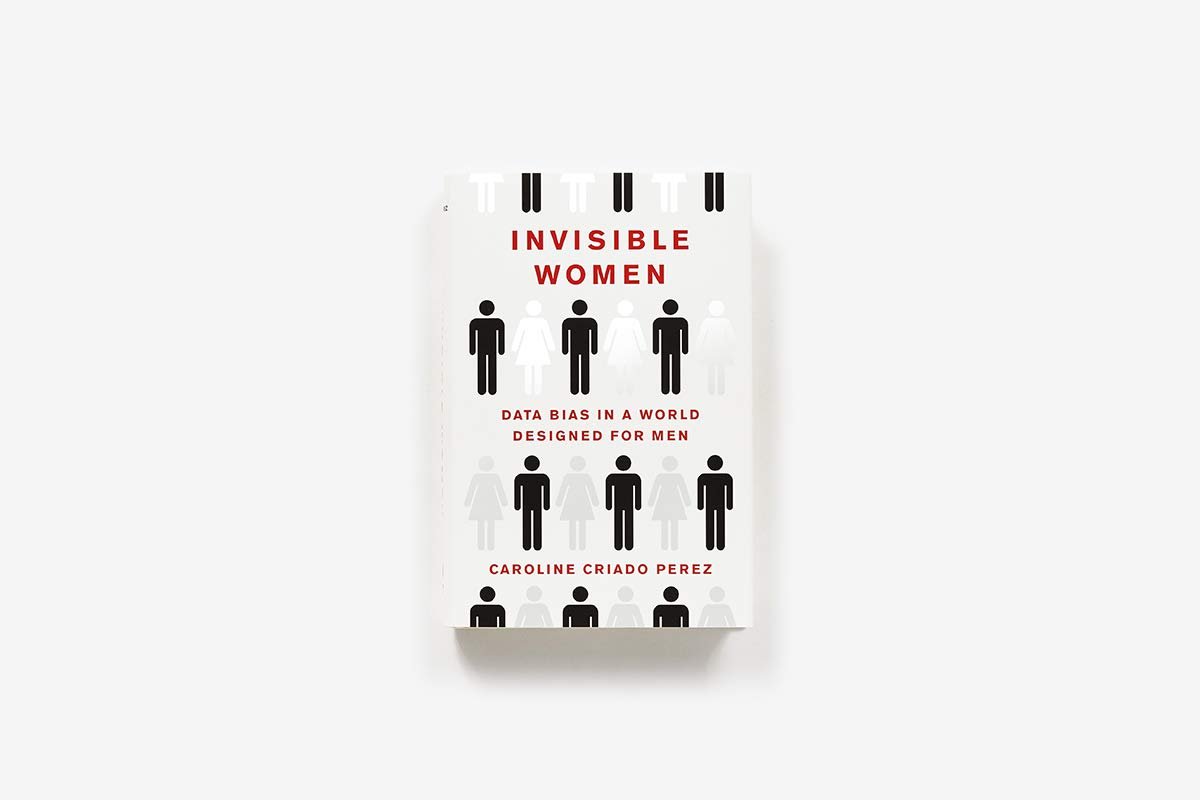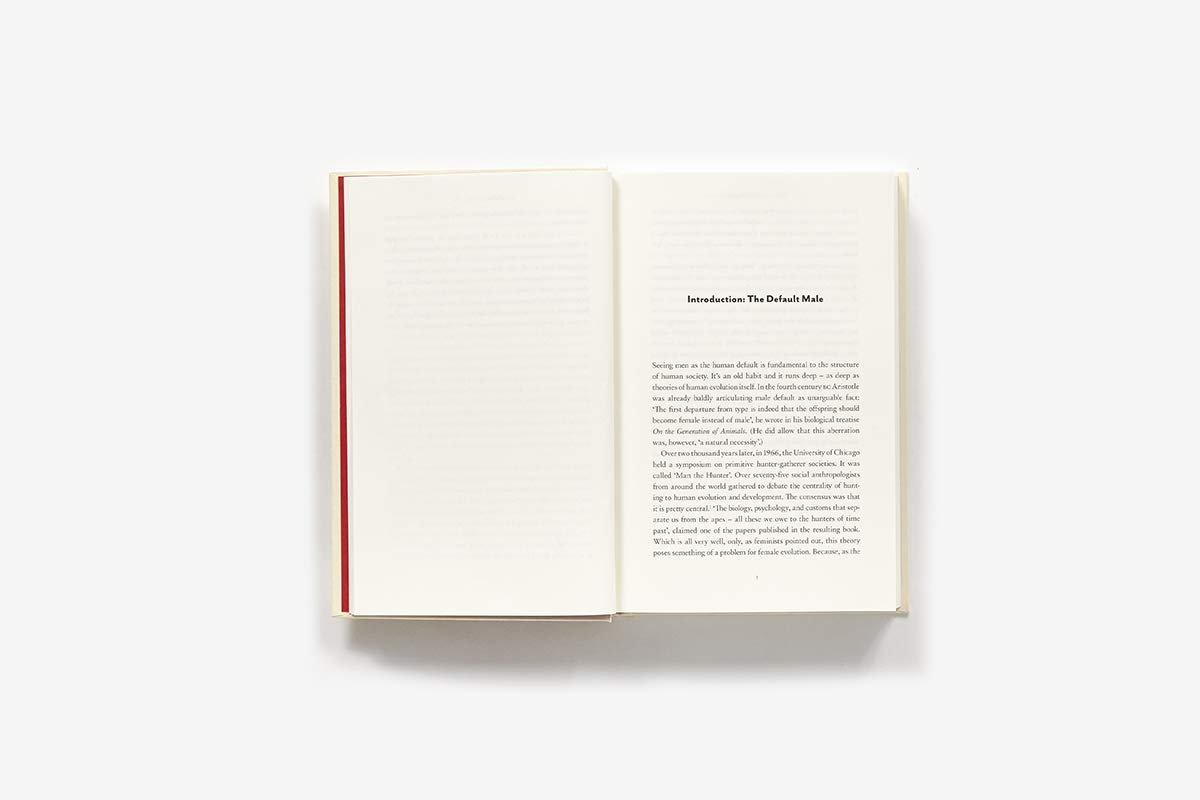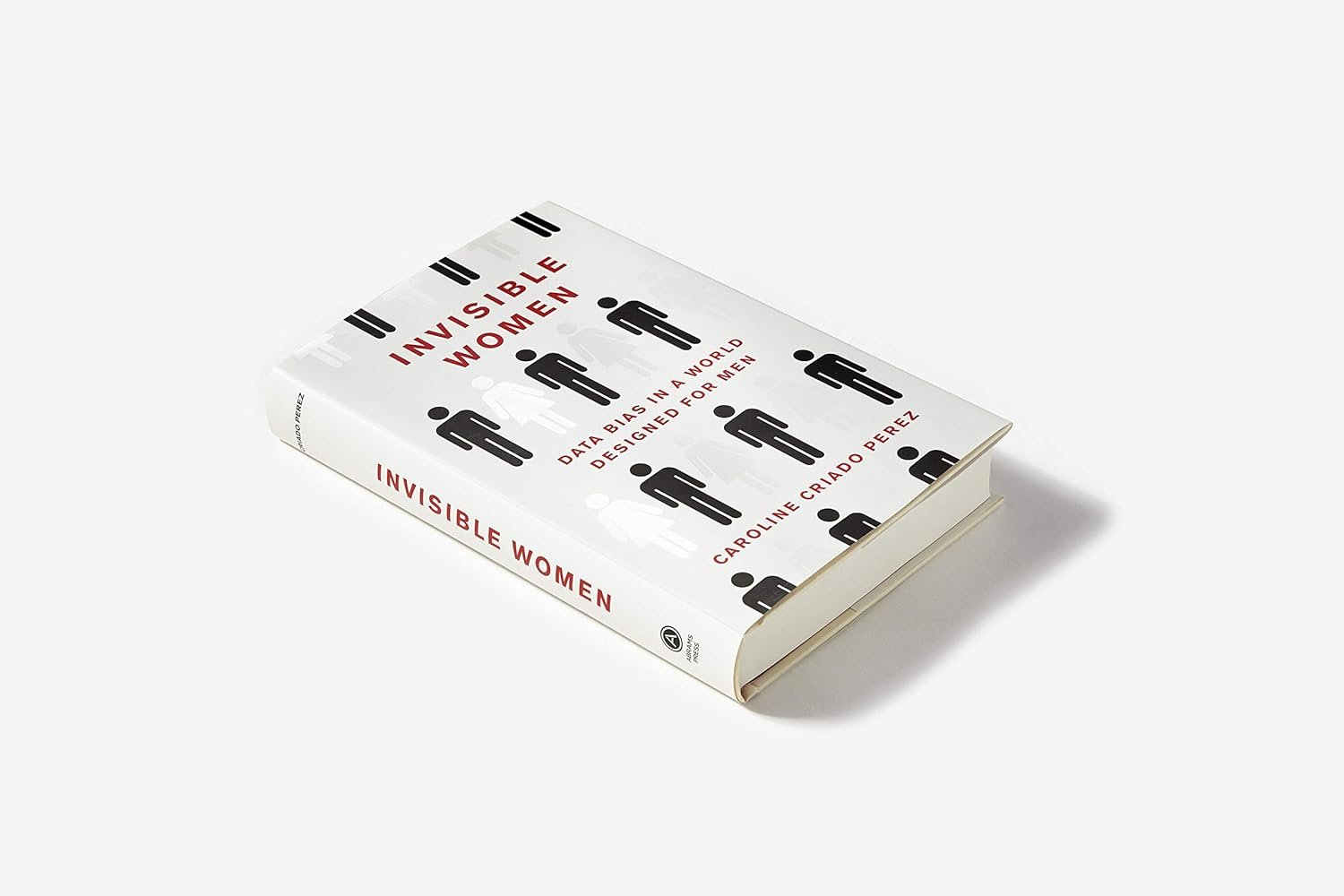The landmark, prize-winning, international bestselling examination of how a gender gap in data perpetuates bias and disadvantages women.
#1 International Bestseller * Winner of the Financial Times and McKinsey Business Book of the Year Award * Winner of the Royal Society Science Book Prize
Data is fundamental to the modern world. From economic development to health care to education and public policy, we rely on numbers to allocate resources and make crucial decisions. But because so much data fails to take into account gender, because it treats men as the default and women as atypical, bias and discrimination are baked into our systems.
And women pay tremendous costs for this insidious bias: in time, in money, and often with their lives.
Celebrated feminist advocate Caroline Criado Perez investigates this shocking root cause of gender inequality in Invisible Women. Examining the home, the workplace, the public square, the doctor’s office, and more, Criado Perez unearths a dangerous pattern in data and its consequences on women’s lives.
Product designers use a “one-size-fits-all” approach to everything from pianos to cell phones to voice recognition software, when in fact this approach is designed to fit men. Cities prioritize men’s needs when designing public transportation, roads, and even snow removal, neglecting to consider women’s safety or unique responsibilities and travel patterns. And in medical research, women have largely been excluded from studies and textbooks, leaving them chronically misunderstood, mistreated, and misdiagnosed.
Built on hundreds of studies in the United States, in the United Kingdom, and around the world, and written with energy, wit, and sparkling intelligence, this is a groundbreaking, highly readable exposé that will change the way you look at the world.
From the Publisher











Publisher : Abrams Press
Publication date : March 12, 2019
Edition : Later Printing
Language : English
Print length : 272 pages
ISBN-10 : 1419729071
ISBN-13 : 978-1419729072
Item Weight : 1.46 pounds
Dimensions : 6.38 x 1.5 x 9.25 inches














K. Johnson –
Exceptionally well-written book describing missing and biased data against women
As a woman working in a STEM field, I was already aware of biases, differences in pay, workplace harassment, and more against women in the workplace. I have experienced it myself. But this book brings a much-needed investigation that goes far beyond my anecdotal incidents and really looks at the data (both what exists and what is missing) and the consequences of dismissing half of the worldâs population as irrelevant or atypical.This book is arranged with a preface, introduction, six sections, an afterword, an epilogue specific to Covid-19, and almost 100 pages of endnotes and index. Although the book (sans endnotes and index) is 326 pages long, it is very readable and so brilliantly written that itâs funny, and sad, and insightful, and infuriating, and more all at once. The author brings to light numerous issues that at first glance didnât really seem to be gender/sex-related at all but after looking at them, they actually are. I think this book would be so helpful for people in many fields, especially in leadership in corporations, government, churches, the medical community, small businesses, and more.Introduction: The Default MaleThe introduction sets up the whole book to show how nearly universally, a default male (body, size, height, weight, shape, behavior, lifestyle, etc.) is used as the default for data, decisions, planning, policies, history, teaching, models, examples, etc. and how this excludes fully 50% of the worldâs populationâs experiences, bodies, behaviors, needs, and values.Part 1: Daily LifeIn the first chapter, âCan Snow-Clearing be Sexist?â, the author reveals how many activities, like plowing the snow from roads, have been set up based on male norms without consideration of how females have different norms. In the case of clearing the roads and sidewalks for travel and commuting, when womenâs needs and patterns were considered, it was found that clearing side roads and sidewalks prior to major roads reduced injuries and accidents and the overall cost of snow conditions compared with the plan which only considered menâs needs and patterns. Chapter two, âGender Neutral with Urinalsâ, looks and bathroom usage and compares the usable square footage and time to use restrooms of menâs bathrooms, which can accommodate more men, with the needs of women who cannot use urinals, often have children or elderly to help, and have physical needs which just take longer than men. As such, equal size bathrooms are simply not equitable. And many worldwide women donât have access to safe facilities at all.Part 2: The WorkplacePart 2 has 4 chapters. âThe Long Fridayâ refers to a day when 90% of women in Iceland decided to strike so that their contributions, many unpaid, would be recognized. Statistically, women do far more unpaid work like childcare, elder care, shopping, cooking, and cleaning compared with men. These tasks cannot be skipped; they are essential but unpaid. âThe Myth of Meritocracyâ shows how advancement in the workplace based on merit favors men who donât have essential unpaid work to do at home and can invest more at work. Furthermore, menâs accomplishments are recognized and rewarded more often even when they are not more merit-worthy than women. âThe Henry Higgens Effectâ refers to a character in My Fair Lady who wonders why women canât be more like men, as if the solution is to force women to act like men rather than recognize that half of the population is not male and behaving like a woman is quite appropriate for women. The final chapter in this section is âBeing Worth Less than a Shoeâ and discusses workplace safety standards and equipment that were developed for men without consideration for the women and their size and physiological differences. âWomen have always worked. They have worked unpaid, underpaid, underappreciated, and invisibly, but they have always worked. But the modern workplace does not work for women. From its location, to its hours, to its regulatory standards, it has been designed around the lives of men and it is no longer fit for purpose. The world of work needs a wholesale redesign â if its regulations, of its equipment, of its culture â and this redesign must be led by data on female bodies and female lives. We have to start recognizing that the work women do is not an added extra, a bonus that we could do without: womenâs work, paid and unpaid, is the backbone of our society and our economy. Itâs about time we started valuing it.â p142.Part 3: DesignIn the section on Design, there are three chapters. âThe Plough Hypothesisâ looks at cultures where farm equipment, designed for men, allowed men who have significantly more upper body strength and hand grip to become the primary income-generating farmers but in cultures that used hoes, both men and women farmed. Farming practices that favor men arenât limited to equipment but also impact crop types. Some high-yield varieties increase the time the women had to spend on cooking and preparing the crops and âcleanâ stoves designed to reduce harmful smoke emissions often increase the effort and time for women to cook and tend to the food. âOne-Size-Fits-Menâ discusses the issues with equipment, gear, and algorithms designed for an average-sized man and how these ill-fitting products do not properly protect, and sometimes even increase risk because they do not fit properly on women simply because women donât have the same size, shape, and expression, as an average man. âA Sea of Dudesâ shares the difficulties women have getting funding for research and products for women when often men are unaware of the needs of women and donât value funding products that they themselves donât need. âDesigners may believe they are making products for everyone, but in reality they are mainly making them for men. Itâs time to start designing women in.â p191.Part 4: Going to the DoctorâWhen Drugs Donât Workâ looks at the practice of testing drugs and dosages on men without considering how well they work (or donât work) on women with different hormones and physiology. My mom is only about 85 pounds and I often wonder if the standard male adult dosage is appropriate for her tiny body. âYentl Syndromeâ starts by comparing typical heart attack symptoms in men versus women. Because symptoms in women differ from men, they are often misdiagnosed, sometimes fatally. Male-dominated funding panels impact how research funding is distributed and diseases that impact primarily women are less likely to be funded and studied. Women typically wait longer, take longer to diagnose, are misdiagnosed more often, and are not taken seriously by the medical community.Part 5: Public LifeâA Costless Resource to Exploitâ delves into the deliberate decision to exclude unpaid womenâs work (childcare, elder care, cooking, cleaning, household activities, etc.) in the GDP. âIt makes sense only if you see women as an added extra, a complicating factor. It doesnât make sense if youâre talking about half of the human race. It doesnât make sense if you care about accurate data.â p241. âFrom Purse to Walletâ looks at tax codes and how they favor men compared with women, particularly in that joint households receive tax credits to the head of the household, typically the man, and women may not have equal access to this money. âWomenâs Rights are Human Rightsâ continues looking at how male-biased policies and gaps in government thinking are harming women. âThe data we already have makes it abundantly clear that female politicians are not operating on a level playing field. The system is skewed towards electing men, which means that the system is skewed towards perpetuating the gender data gap in global leadership, with all the attendant negative repercussions for half the worldâs population.â p286.Part 6: When it Goes WrongâWho will rebuildâ shows that âwhen things go wrong â war, natural disaster, pandemic â all the usual data gaps we have seen everywhere from urban planning to medical care are magnified and multiplied. But itâs more insidious than the usual problem of simply forgetting to include women. Because if we are reticent to include womenâs perspectives and address womenâs needs when things are doing well, thereâs something about the context of disaster, of chaos, of social breakdown, that makes old prejudices seem more justified. The real reason we exclude women is because we see the rights of 50% of the population as a minority interest.â p290. âItâs Not the Disaster that Kills Youâ continues by pointing out that during disasters, it is women who are disproportionally negatively impacted. Women face increased domestic violence, trauma, displacement, injury, death, and female-specific injustices during warfare, pandemics, and natural disasters.The afterword offers some hope when womenâs voices are included. Women bring valuable insight into the experiences of half the population and their experiences are good for business, economy, and humanity. The epilogue was added to specifically address the Covid-19 pandemic and, unsurprisingly, the âcontinual failure to systemically collect and sex-disaggregated data on symptoms, infection rates, and death rates from Covid-19.â p319. And of course, PPE that fit women (like masks) were disproportionally unavailable for the many women in healthcare settings who needed them.I found this book very well written, meticulously footnoted, and very eye-opening even though I was aware of some of the issues already. I would highly recommend the book to all leaders and all women. Although the author touched on womenâs clothing and fashion, I wish she had chewed on it a little more, especially considering how men are able to purchase pants by style, waist size, and inseam whereas rarely are women offered the ability to buy based on measurements and most pants have only one inseam length as if all women are the same shape and height. Women, their bodies, and their needs matter in all areas of life and we should be considered.
Jeffrey P –
Brilliant (and infuriating). A must-read!
10/5 stars. This book is data-driven, detail rich and nuanced. It highlights the systemic ways that women & girls have been excluded from science, medical development, and community work and how that exclusion hurts communities. (Example: Crash test dummies are only created in average adult male sizes, not women sizes, and shocker, women are more likely to be seriously injured in car accidents than men.)This book honors the incredible advancements we have already made in science, tech, medicine, etc, and calls for future development to include women & girls. This is not a hate-bash against men or innovation that already exists, but a call to continue filling in our data gaps and systemic failures. It is thoughtful, important read.
Beguiled By Books –
Good book about data and unconscious biases.
Published in 2019, Invisible Women: Data Bias in a World Designed for Men by Caroline Criado Perez tells the story of how women have been underrepresented, or outright missing, from studies and data as far back as data collecting goes. The author’s premise is that all of humanity suffers from an inherent yet unintentional bias against women due to this lack of data.There were some eye-opening parts to this book. The data and studies are well documented throughout, which helps to prove the author’s hypotheses and points. Using that data, Perez shares detailed explanations of why the lack of data on women affects decision-making for current and future generations on both micro and macro levels. I also enjoyed that many industries (transportation, technology, healthcare) and countries (Bangladesh, Brazil, UK, Sweden) were noted.While there were many great elements of the book, naturally, there are things I didn’t love. The author got perhaps too biased and let her personal opinions color the data at some points. As a woman who is not a mother, I also felt that Perez did not do a great job of separating “woman” from “mother.” I’m sure there’s a reason for that, and for the most part, I’d guess that, around the world, most women are mothers. However, it did leave me asking questions about the data surrounding domestic work when women are not mothers. Finally, about halfway through the book, Perez began asking many “what-if” and “what-about” questions where the only solution was “collect more data on women.” While the answer is a resounding, “yes, we need more data on women, and we need sex-disaggregated data,” how do we get that? What changes are we making in academia, in the field, and globally to collect new or improved data?I was left without an answer to that question.Perhaps the point of this book was to shed light on the lack of data on women. However, this book felt a bit like hot-potato: yes, it’s a problem, but no one, including the author, is offering tactical solutions to remedy it.Invisible Women is a must-read, but there’s still bias built-in.
Crystal –
So IMPORTANT to read
This book is a must-read! So much eye-opening information.Medical data, as we know it, has always been based on a man’s body.Women are NOT smaller men.I highly recommend that everyone buy this book better to understand the discourse around feminism and the patriarchy.
Kayla –
Things We Should Be Teaching
As a teacher, I felt so strongly as I read this that this is something we are missing in the education system. Iâm so glad to have this compilation of data in such a digestible format. The author wrote in a way that made you crave more information, it was never boring.
Jane Michalski –
Worth the read
This is a very interesting book on how the world is planned without giving due thought to how it affects 50% of the population (women). Lots of statistics and fully referenced.
Kindleã®ãå®¢æ§ –
Over 40% of the number of pages are references, that’s to show the amount of research was put in this book. It’s worth it and you’ll soon be talking about it with everyone around you, because the topic is just too present in our day to day. We just choose to ignore it. This book brings it to conscious.
Sanny Zi –
Cosas interesantes, números, y injusticias. La mitad leo yo y la otra mitad cuento a mi marido! Es un must have para todas las personas.
hero_of_canton –
Itâs not hyperbole to say that data bias is affecting every area of womenâs lives; from medical research and technology to government policy and their workplaces. The world is built with men as the standard and women an afterthought at best, often with disastrous consequences.Wow. This was such an eye opening read. There were some parts that I knew, the fact that women are 47% more likely to be injured in a car accident due to crash test dummies being built based on male bodies was one, but many more that I wasnât aware of. The lack of female participants in medical trials probably shouldnât have surprised me but did. Even drugs specifically intended for women arenât generally tested on women.Criado Perezâs writing is incredible. Sheâs done so much research and gathered together an overwhelming amount of evidence as well as calling for solutions.This book is not a stick with which to beat men, Criado Perez explains the circumstances in how this data gap came to be and pushes for people to do better. She points out the failings in data not being disaggregated by sex.Ironically, some of the problems come from the idea that feminism is calling for equality between the sexes, when what is really needed is equity. Instead of pretending the differences donât exist and attempting to treat everyone the same, we need to acknowledge where there are differences and give people what they need to close the gap.This is something Iâve thought a lot about in my life as a martial artist. The doboks we wear are clearly designed with one shape in mind, an athletically built male. Iâm sure it could be argued that equality was in mind in ensuring we all wear the same but that isnât the way human bodies work and womenâs bodies, specifically, need a different style.More than anything, this book served as reminder of how far weâve come but also how far we still have to go.
Tiffani –
Itâs one of those books you canât stop reading but at the same time makes you really frustrated with the world, so be aware.
BB –
I read this book not long after it was published and was struck by the thorough and wide-ranging evidence base it constructs.The simple fact is that there are physiological differences between females and males, and these size and other differences are often not taken into account in product design or public policy development. From crash test dummies designed around the average white male’s height and weight to the countless powertools designed for the grip size of a large male hand, women (specifically: females) are systematically left out of the picture.This is a separate issue to the gender stereotyping we increasingly see in products, whereby it’s hard to buy clothes for girls that aren’t pink, sparkly and covered in unicorns, and toys get separated into “girls’ toys” and “boys’ toys”. (There’s no such thing â there’s just toys.)This book is a must-read and bears re-reading.